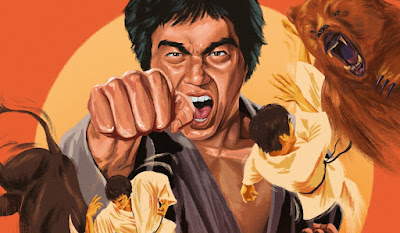 |
| Images courtesy of Eureka Entertainment |
Japanese Toei film director Kazuhiko Yamaguchi did his fair
share of gritty and violent period street-fighter films involving tough female
assassins such as his Wandering Ginza Butterfly films and the Sister
Street Fighter films before arriving upon what is perhaps the
quintessential penultimate Sonny Chiba outings with Champion of Death aka
Karate Bullfighter followed by Karate Bearfighter in the same
year of 1975. Loosely based on the 1971 manga
A Karate-Crazy Life by Ikki Kajiwara with artistic renderings by Jiro
Tsunoda and Joya Kagemura, the text told the story of Mas Oyama, the founder of
Kyokushin Karate who is universally considered to be the first and foremost
influential style of full contact karate.
Known to have killed fighting bulls including cutting off
their horns with his bare hands, earning the nickname ‘Godhand’, the legendary
(perhaps tall) tale of Mas Oyama was perfect cannon fodder for both director
Yamaguchi and actor Chiba who made a total of three films involving the
character. While the third one Karate
for Life is absent from this forthcoming Eureka Entertainment blu-ray boxed
set, the aptly named Beast Fighter box comprised of the first two entries
Karate Bullfighter and Karate Bearfighter have been included here
for the first time with newly minted digital restorations provided by Toei
Films.
In the first film Karate Bullfighter, a karate
tournament is in session, practicing the ‘dance’ karate style when it is
abruptly violently interrupted by the arrival of Korean fighter Choi Bae-dal
who ultimately would change his name to Mas Oyama (Sonny Chiba). Appearing in rags looking like a homeless
ragamuffin, the mercurial martial artist all but makes quick and easy work of
the karate tournament in a swift victory but not before the promoter offers him
a job. During a drunken brawl one night
he kills the leader of a gang and renounces karate altogether including
residing with and helping the family of the man he has killed on their farm. However, cover is blown as assassins are
tasked with finding him, forcing him to do battle in the style of karate once
again.
Picking up right where Bullfighter left off, Karate
Bearfighter of the same year (decidedly the lesser of the two) is expelled
from the karate community due to his unwillingness to compromise the ferocity
of his murderous kicks and punches.
Bumping into an old Imperial Air Force pal Kimura (Hideo Murota) who
offers him a job as a bodyguard in the yakuza world which quickly proves to be
demeaning work where his efforts engender more scorn than reward. Along the way, he encounters and befriends street
rats Kozuro and Sumiko (Yutaka Nakajima) whom he strongly suggests they
marry. However, being a hot target, assassins
from a rival karate school out to get Oyama proceed to brutally murder the
young lovebirds, causing Oyama to pursue bloodthirsty revenge on their
behalf. At some point in the story,
there’s a scene where Oyama takes on a grizzly bear that is unfortunately
clearly a man in a bear costume.
While clearly the weaker successor of the two, both of the Beast
Fighter films are stellar larger-than-life loosely based on a true story
examples of Sonny Chiba’s screen presence and aura. Although not quite on the same level as Bruce
Lee, the multitalented actor gives some of his best work in both movies
displaying a wealth of physicality as well as emotion just lurking behind his
stoic thick-rimmed sunglasses. One thing
fans will notice immediately as both films unfold is the original score by
Shunsuke Kikuchi, sneakily cribbed by Quentin Tarantino during the House of
Blue Leaves fight in Kill Bill Vol. 1.
An energetic and involved, exciting score with hints of guitar rock radiating
through it, it fully completes the pop cultural circle of Sonny Chiba for those
introduced to his oeuvre through Tarantino.
The cinematography by Yoshio Nakajima in Toeiscope 2.35:1 on
both pictures ranges from elegantly framed wide shots to intense, near
Fukusaku-esque hand-held camerawork including first-person point-of-view fight
scenes that make you feel as though you’re engaged in the exchanges of punches
and kicks. Often switching between wide
vistas of the school fighting grounds, villages or forests where battles spill
out and tight close-ups of Chiba’s face (particularly his eyes), both movies
give you the sense of what it was like to be in those close contact combat
fights Oyama lived through. Besides
Chiba’s acting who really does convey a lot of emotion and heart onscreen for a
character we feel inclined to hate upon first meeting him, the ensemble cast
across both movies is solid with special attention going to a sneaky cameo by
none other than the real Oyama.
Though sadly excluding the third film from the set, this
limited-edition box housing the first two entries in the trilogy is
nevertheless an integral addition to one’s East Asian film library while also
gaining a greater understanding of the full-scale breadth of Sonny Chiba’s
screen aura. Probably the most
physically and emotionally involved Chiba outings yet, the films presented on
blu-ray for the first time feature collectible booklets featuring new essay
writing by Eddie Falvey, a video essay by martial arts movie expert Jonathan
Clements and a limited collectible slipcover.
For those who have seen a wealth of Sonny Chiba action or yakuza films,
these are most certainly at the top of his resume and remain stellar martial
arts driven entertainments!
--Andrew Kotwicki





